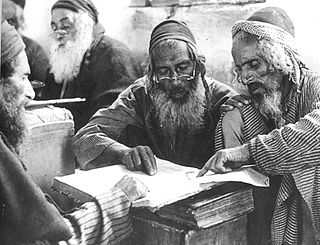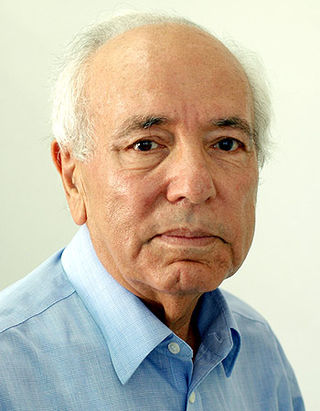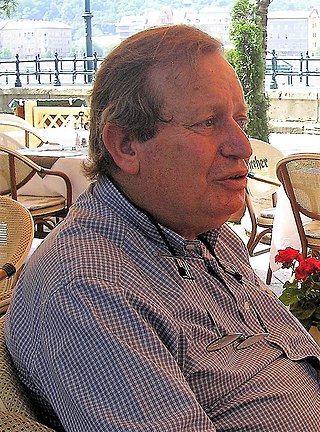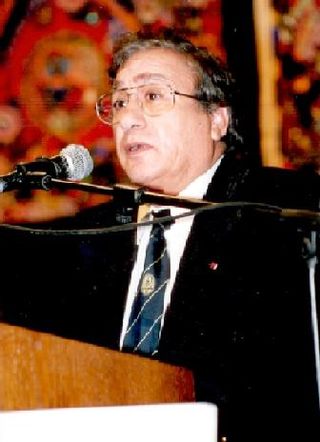
One Thousand and One Nights is a collection of Middle Eastern folktales compiled in the Arabic language during the Islamic Golden Age. It is often known in English as the Arabian Nights, from the first English-language edition, which rendered the title as The Arabian Nights' Entertainment.
Arabic literature is the writing, both as prose and poetry, produced by writers in the Arabic language. The Arabic word used for literature is Adab, which comes from a meaning of etiquette, and which implies politeness, culture and enrichment.

Judeo-Arabic is Arabic, in its formal and vernacular varieties, as it has been used by Jews, and refers to both written forms and spoken dialects. Although Jewish use of Arabic, which predates Islam, has been in some ways distinct from its use by other religious communities, it is not a uniform linguistic entity.

Yemenite Hebrew, also referred to as Temani Hebrew, is the pronunciation system for Hebrew traditionally used by Yemenite Jews. Yemenite Hebrew has been studied by language scholars, many of whom believe it retains older phonetic and grammatical features lost elsewhere. Yemenite speakers of Hebrew have garnered considerable praise from language purists because of their use of grammatical features from classical Hebrew.

Yehuda Alharizi, also Judah ben Solomon Harizi or al-Harizi, was a rabbi, translator, poet, and traveler active in al-Andalus. He was supported by wealthy patrons, to whom he wrote poems and dedicated compositions.

Abū Muḥammad ʿAbd Allāh ibn Muslim ibn Qutayba al-Dīnawarī al-Marwazī better known simply as Ibn Qutaybah was an Islamic scholar of Persian descent. He served as a judge during the Abbasid Caliphate, but was best known for his contributions to Arabic literature. He was an Athari theologian and polymath who wrote on diverse subjects, such as Qur'anic exegesis, hadith, theology, philosophy, law and jurisprudence, grammar, philology, history, astronomy, agriculture and botany.
Islamic literature is literature written by Muslim people, influenced by an Islamic cultural perspective, or literature that portrays Islam. It can be written in any language and portray any country or region. It includes many literary forms including adabs, a non-fiction form of Islamic advice literature, and various fictional literary genres.

Dan Miron is an Israeli-born American literary critic and author.
Gershon Shaked (1929–2006) was an Israeli scholar and critic of Hebrew literature.

Ori Kritz is an Associate Professor and head of the Hebrew Language and Literature program at the University of Oklahoma, a part of the Judaic Studies department. She is a multilingual writer and speaker, specializing in Yiddish, Hebrew, and Jewish literature and in Jewish and Israeli humor.

Sasson Somekh was an Israeli academic, writer and translator. He was professor emeritus of Modern Arab Literature at Tel Aviv University.

Reuven Snir is an Israeli Jewish academic, Professor of Arabic language and literature at the University of Haifa, Dean of Humanities, and a translator of poetry between Arabic, Hebrew, and English. He is the winner of the Tchernichovsky Prize for translation (2014).

Israel Bartal, is Avraham Harman Professor of Jewish History, member of Israel Academy of Sciences (2016), and the former Dean of the Faculty of Humanities at Hebrew University (2006–2010). Since 2006 he is the chair of the Historical Society of Israel. He served as director of the Center for Research on the History and Culture of Polish Jewry, and the academic chairman of the Project of Jewish Studies in Russian at the Hebrew University of Jerusalem. Professor Bartal was the co-director of the Center for Jewish Studies and Civilization at Moscow State University. Bartal received his PhD from Hebrew University in 1981. He focuses his research on the history of the Jews in Palestine, the Jews of Eastern Europe, the Haskalah Movement, Jewish Orthodoxy and modern Jewish historiography.

Avidov Lipsker is an Israeli professor of Hebrew Literature at Bar Ilan University in Israel.

Shmuel Moreh was a professor of Arabic Language and Literature at the Hebrew University of Jerusalem and a recipient of the Israel Prize in Middle Eastern studies in 1999. In addition to having written many books and articles dealing with Arabic literature in general and Iraqi Jewish Arabic literature in particular, he has been a major contributor to Elaph, the first online daily independent journal in the Arabic language. Professor Moreh wrote in Arabic, Hebrew, and English.
The golden age of Jewish poetry in Al-Andalus developed in the literary courts of the various taifas. Like its Arabic counterpart, its production diminished in the 12th century under the rule of the Almoravids and Almohads. In the last part of the 10th century, Dunash ben Labrat revolutionized Jewish poetry in Al-Andalus by bringing Arabic meter and monorhyme into Hebrew writing. Jewish poets employed Arabic poetic themes, writing bacchic poetry, garden poetry, and love poetry.
Ihud Bnei HaBrit is an Israeli political party that participated in the April 2019 Israeli legislative election. It is mostly an Arab Christian party, with some Jewish and Muslim support.
Yemenite Jewish poetry, often referred to as "paraliturgical poetry" because of its religious nature, has been an integral part of Yemenite Jewish culture since time immemorial. The Jews of Yemen have preserved a well-defined singing arrangement which not only includes the very poetic creation itself, but also involves a vocal and dance performance, accompanied in certain villages outside Sana'a by drumming on an empty tin-can (tanakeh) or a copper tray. The Jews of Yemen, maintaining strict adherence to Talmudic and Maimonidean halakha, observed the gezeirah which prohibited playing musical instruments, and "instead of developing the playing of musical instruments, they perfected singing and rhythm." This arrangement was integrated into the walks of life familiar to the Jews of Yemen. The texts used in the arrangement were put down in writing and later included in separate song collections (dīwāns). The social strictures and norms in Yemenite Jewish culture provide for separate settings for men and for women, where the sexes are never mixed. Men’s song usually expressed the national aspirations of the Jewish people, and it was far removed from the singing associated with the Muslim environment, whereas folk songs of Jewish women were sung by rote memory and expressed the happiness and sorrows inherent in their daily life and was, as a rule, closer to that of Muslim women.

From Language to Language is a 55-minute 2004 Belgian-French-German-Israeli Hebrew-language independent underground experimental documentary art film directed by Nurith Aviv.

David Semah was an Israeli scholar of Arabic literature in Israel, and a professor at the Department of Arabic Language and Literature at the University of Haifa. As one of the founders, he remained closely involved in the Department's activities from its establishment in the mid-1960s and until his death.














